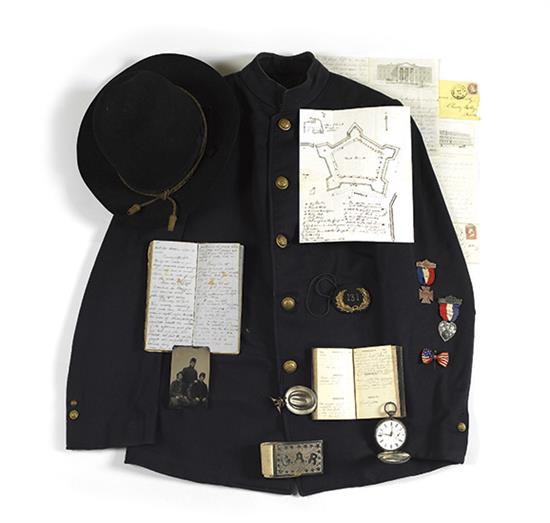Sale 2324 - Lot 129
Unsold
Estimate: $ 6,000 - $ 9,000
(CIVIL WAR--MASSACHUSETTS.) Large archive of army engineer Jerome Bottomly, including letters, diaries, and his G.A.R. uniform. 103 items, including: A pair of manuscript diaries spanning Bottomly's entire 3-year enlistment * 54 war-date Autograph Letters Signed to his parents and sisters, two on illustrated letterhead, many with stamped envelopes * 6 other war-date documents and letters addressed to Bottomly * 27 post-war letters and documents, most relating to veteran activities and benefits, 1865-1915 * Grand Army of the Republic jacket, hat and belt * 6 related G.A.R. badges and accessories * Pocket watch * Tintype portrait of 3 Civil War engineers in uniform, presumably including Bottomly * 2 G.A.R. photographs * and a 34-page veteran's roster of Bottomly's battalion updated through 1897. Vp, 1861-1915
Additional Details
Jerome Bottomly (1842-1912) was a farmer in Cherry Valley, MA (near Worcester) when the war started. He served a three-year term as an artificer in the 1st Battalion, United States Engineers, from September 1861 through 1864. The battalion served in the Peninsular Campaign, Antietam, Fredericksburg, Chancellorsville, and the Wilderness, building the bridges and corduroy roads that kept the Union troops moving. His diaries express the hard work and danger of this vital work, such as this 1 June 1862 entry: "We built two bridges, working up to our knees in water. Lieut Babcock and twelve men were ordered by Gen. Barnard to examine the road on the other side; the Rebels fired several shots and hit one of our men, the bullet going through his right lung."
Bottomly's battalion bore arms and was trained as infantry, and was often near the front lines. At Antietam, he wrote: "A great battle. We were in plain sight of the field, 3/4 of a mile from it. McClellan was near us part of the day. It is now the middle of the afternoon and I think our men have the best of it" (17 September 1862). At the Battle of the Wilderness, he wrote "Went to the front and laid in the rifle pits all the forenoon, in the afternoon was diging rifle pits when our right broke. We laid in line all night" (6 May 1864). Four days later, he summarized the frustration of life as a military engineer: "Went to the right to build a bridge . . . got it nearly done when Hancock ordered us to destroy it" (10 May 1864).
Probably Bottomly's most dangerous day was at Fredericksburg, where he wrote: "I can remember what happened this day better than I can write it. I ought to thank God my life is spared" (11 December 1862). That day Union engineers built a bridge into the city while under heavy fire from Confederate sharpshooters operating the protected cellars nearby. Two days later, he wrote "Heavy cannon firing in the forenoon and this afternoon volleys of musketry. A terrible battle is going on. . . . I pray God to watch over me."
Bottomly sketched several buildings and two uniformed soldiers in his diary, and one of his letters dated 10 November 1861 includes a full-page plan of Fort Independence in Boston. This archive--the diaries, letters, the uniform, his discharge certificate--tells the whole story of an Army engineer, one who faced more immediate danger than many infantrymen did.
Bottomly's battalion bore arms and was trained as infantry, and was often near the front lines. At Antietam, he wrote: "A great battle. We were in plain sight of the field, 3/4 of a mile from it. McClellan was near us part of the day. It is now the middle of the afternoon and I think our men have the best of it" (17 September 1862). At the Battle of the Wilderness, he wrote "Went to the front and laid in the rifle pits all the forenoon, in the afternoon was diging rifle pits when our right broke. We laid in line all night" (6 May 1864). Four days later, he summarized the frustration of life as a military engineer: "Went to the right to build a bridge . . . got it nearly done when Hancock ordered us to destroy it" (10 May 1864).
Probably Bottomly's most dangerous day was at Fredericksburg, where he wrote: "I can remember what happened this day better than I can write it. I ought to thank God my life is spared" (11 December 1862). That day Union engineers built a bridge into the city while under heavy fire from Confederate sharpshooters operating the protected cellars nearby. Two days later, he wrote "Heavy cannon firing in the forenoon and this afternoon volleys of musketry. A terrible battle is going on. . . . I pray God to watch over me."
Bottomly sketched several buildings and two uniformed soldiers in his diary, and one of his letters dated 10 November 1861 includes a full-page plan of Fort Independence in Boston. This archive--the diaries, letters, the uniform, his discharge certificate--tells the whole story of an Army engineer, one who faced more immediate danger than many infantrymen did.

Exhibition Hours
Exhibition Hours
Aliquam vulputate ornare congue. Vestibulum maximus, libero in placerat faucibus, risus nisl molestie massa, ut maximus metus lectus vel lorem.


